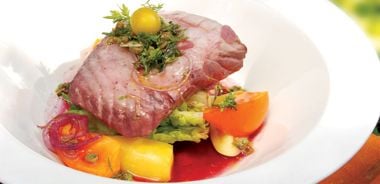Baked Albacore Tuna with Fresh Herbs and Capers and Salsa

This dish delves into the herb box to deliver a dose of fall freshness that can be enjoyed year-round. Dried herbs deliver the flavour, but halve the quantities for fresh herbs used below.
6 - 1/3 lb (140 g) Pacific, trawl-caught albacore tuna steaks (you may substitute halibut, if you prefer)
1 medium onion, sliced
2 cloves garlic, minced
2 whole anchovies
1 tsp (5 mL) fresh rosemary
1 tsp (5 mL) dried oregano
1/2 cup (125 mL) fresh mint leaves
Salt, to taste
1 pinch black pepper
1 Tbsp (15 mL) butter
1/4 cup (60 mL) olive oil
1/2 cup (125 mL) fish stock
1/2 cup (125 mL) red wine, preferably Syrah
Preheat oven to 425 F (220 C). Lightly grease a baking dish with olive oil. Place tuna in the dish and surround with onion and garlic. Season with anchovies, rosemary, oregano, and mint. Add salt and pepper.
Dot with bits of butter and drizzle with olive oil. Bake for 5 minutes; add fish stock and wine. Return to oven and cook for another 5 minutes or until tuna is tender.
To serve, place the albacore tuna in centre of plate, pour pan juices and onions over. Top with salsa and enjoy.
Salsa
3 Tbsp (45 mL) red wine vinegar
1/2 tsp (2 mL) sugar
1/2 lemon, juiced
1/4 cup (60 mL) extra-virgin olive oil
1 clove garlic, minced
1 tsp (5 mL) fresh oregano, chopped
2 Tbsp (30 mL) fresh parsley, chopped
1 Tbsp (15 mL) fresh mint
1 tsp (5 mL) fresh thyme leaves
1/2 tsp (2 mL) fresh rosemary
2 Tbsp (30 mL) capers, rinsed
Salt, to taste
In a medium bowl, mix vinegar and sugar. Whisk until sugar is dissolved. Add lemon juice, olive oil, garlic, oregano, parsley, mint, thyme, and rosemary. Mix well. Stir in capers. Salt as needed.
Serves 6.
source: "West Coast Wonder", alive #301, November 2007




